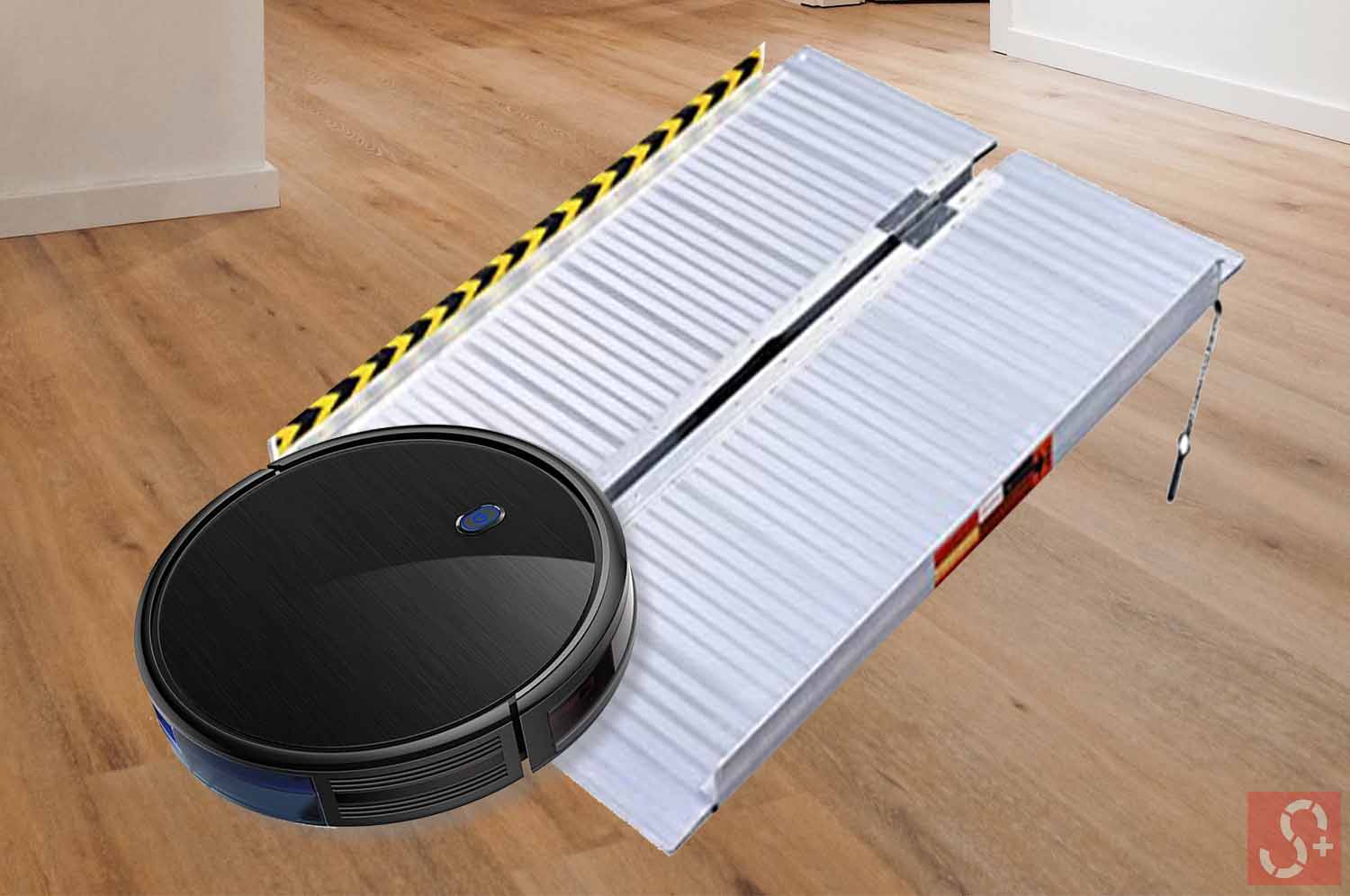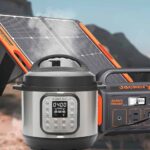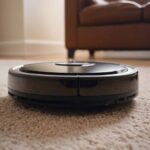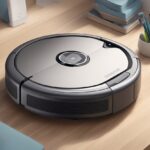Robot vacuums are one of the best simple lifesavers for the home. But, living in a split-level home, questions about their ramp climbing ability naturally arise.
Key Takeaways:
Generally, robot vacuums can go up or down ramps when the slope is suitable, and the approaching threshold of the ramp is not too high. However, the robot vacuum’s cliff sensors can get triggered when the ramp is too steep, causing it to not traverse the ramp consistently.
So, keep reading till the end to learn more about robot vacuum ramps, how you can make your own DIY ramp, and more in this detailed guide.
Can Robot Vacuums Go Up Or Down Ramps?
Robot vacuums can handle small bumps and thresholds. But there are no commercially available robot vacuums that can climb stairs or other similar surfaces (ramps are slightly different for them).
Standard midrange robot vacuums typically don’t have cameras to see everything around them. Instead, they rely mainly on several sensors (bump, cliff, and wall sensors) to navigate the world around them.
The sensor that mainly gets triggered while moving near any stepped surface is the Cliff Sensor.
Typically, the Cliff Sensor works by calculating the distance between the robot base and the floors to help the robot vacuum make necessary judgments.
The cliff sensors are usually located at the device’s edges to prevent the device from falling down stairs and steep drops.
Nowadays, it is very rare to have a robot vacuum without a built-in cliff sensor. For instance, Roomba 500, e series, and the i series – all come with a cliff sensor.
Infra-red lights are often used in the process of scanning and mapping out the surroundings. The sensor continuously keeps emitting infrared light, and light immediately returns to the device.
So suppose that suddenly there is a significant increase in the distance between the robot base and the floor. Then, the sensor will get triggered. And the robot vacuum won’t move farther, assuming it has reached the stair edge or the surface from where it could fall.
The problem with letting the robot vacuum climb up the ramp or move down is that this sensor gets triggered when the ramp is too steep.
So this is an essential thing to consider when you design the ramp for the robot vacuum.
How To Make A Robot Vacuum Ramp?
Before you build a ramp for your Robot vacuum, it’s quite important to address these essential questions:
- How high of a step-up the wheels of your Robot Vacuum can handle?
- What is the maximal angle of arrival and departure of the slope your robot vacuum can handle?
Addressing these two questions is necessary because they allow you to build the perfect ramp right off the bat without any issues.
The front bumper of the robot vacuum is one of the key factors that block it from getting over something.
The sensors will get triggered if the bumper hits the ramp surface while approaching it and cannot clear the way. And as a result, it will struggle to climb up the ramp.
Hence, it depends on the Robot vacuum brand you are using. Once you figure out the threshold climbing ability, you can set the ramp upstairs accordingly.
| Popular Robot Vacuum Brands | Max Threshold Height |
| Roborock S, E, and C series (except S4) | 2cm |
| iRobot Roomba | 1.6 cm |
| Ecovacs Deebot | 0.8 – 2cm |
| Shark | 1.9 cm |
Sometimes these robot vacuums can get too smart and may reject the decision to go up a ramp. So the next essential thing to identify is the maximum angle of the slope the robot vacuum can handle. How can you do that?
How Steep of a Slope Can Robot Vacuums Climb?
Robot vacuums have come far in terms of technology and in automating our home cleaning experience. But unfortunately, there aren’t any that can climb stairs.
And there are no official records published regarding how steep an angle a particular robot vacuum can climb. So all you are left with is trying it out yourself – a mock test is the way to go!
Before you finally set up the ramp, it is good to test the ramp steepness tolerance of your robot vacuum using cardboard ramps.
Cardboard is the best thing to use for setting up the mock ramp – since you can cut it and adjust it easily based on your needs.
For example, let’s say you want to test the ramp climbing ability of the Roomba Robot Vacuum.
We already know its threshold climbing ability is 1.6 cm. So, you can cut out the cardboard and set the ramp accordingly, and for the start, you can start with a 30° slope.
Then, slowly you can decrease the angle by reaching up to 10° and so – depending on the available space. And see how the robot vacuum moves on the ramp and at which slope angle it is more comfortable moving.
Additionally, it is also good to set up barriers along the sides of the ramp. It works well as the path guide and keeps the robot vacuum from falling.
Here’s a great video that gives a practical demonstration of testing the robot vacuum on a ramp:
Once you successfully complete the mock test, figure out the ideal slope angle, threshold climbing ability, and overall design – it’s time to deploy the actual ramp.
Now, there are a wide variety of options available. But the best ramp for robot vacuums can be made using wooden boards.
You can visit your local hardware store or sites like Amazon and get a few hardboard sheets. And nails or screws to help support the structure.
Another good solution, if you’re not looking to go down the DIY route, is to use a wheelchair ramp. The metal color may not blend well with the rest of your decor, but it’s very functional and sturdy. They can also be found on Amazon.
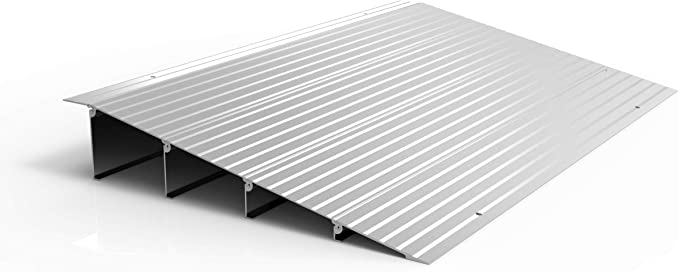
Wooden surfaces are the best choice for making the ramp because they are hard enough to support the robot vacuum movement and are fairly inexpensive.
However, other options also exist if you can’t have wooden surfaces as ramps.
How To Clean Multiple Floors?
Here are the two ways in which you can clean multiple floors in a stepped house:
#1. Scheduling The Robot Vacuums In Each Room
One of the simplest ways to ensure the cleanliness of each room is to schedule a robot vacuum for every individual room.
You have to manually pick up the robot vacuum and place it in each room that needs cleaning.
We understand that picking up a robot vacuum every time and placing it in the next room can be a hassle. After all, by doing this, you also lose automation somewhat.
But if you don’t consider it a big task, it is the most practical way to clean multiple-stepped rooms with a robot vacuum.
#2. Having 2 Separate Robot Vacuums For Multiple Floors
If you have the budget, another solution is to buy separate robot vacuums.
If you have a sunken living room, you can get a small and relatively cheaper robot vacuum specifically for that room. And for the rest of the house, the old robot vacuum should be enough.
Sounds simple? Well, yes, but the problem becomes complicated when multiple stepped rooms exist.
It’s not practical to have a robot vacuum for every room. Ideally, in such a situation, the first option, picking up the vacuum and scheduling it for each room, makes more sense.
Are There Robot Vacuums That Can Climb Stairs?
Currently, there are no robot vacuum cleaners that can climb stairs and can be used for home cleaning purposes. However, technological advancements and research are done, so one can expect such robot vacuums in the future.
According to a report, Dyson (a well-known brand that makes vacuum cleaners) has started designing robots that can climb stairs!
The company has spent around 16 years designing a robot vac that cleans and climbs the stairs simultaneously.
Moreover, according to the filed patents, the robot can hold a cup or open a drawer.
But it is essential to highlight that it is still unclear whether it is just an idea on paper or a process already in the planning stages.
Another technological advancement in this direction is by Alphabet (a subsidiary of Google’s parent company). The company has developed a two-legged robot that can climb and clean stairs.
The bi-pedal robot is capable of cleaning the stairs using the vacuum attachments on its feet.
The robot is built by the Japanese robotics firm Schaft, and it can do various things like stepping over obstacles, cleaning stairs, or even carrying weights.
Platypus Labs is another brand that has started doing technological advancement and research for stair climbing robot vacuums. They have named their product Tenzing which will have a compact stair climbing mechanism and clean the corners.
From research and concept generation to the prototyping process, the company seems to be doing thorough research in this direction.
Can I Use Robot Vacuums On The Stairs?
You can’t use robot vacuums on stairs because robot vacuums are not made for that purpose. Although highly impractical, if the step is large enough, a smaller robot vacuum may work.
Despite the technological advancements and promising research, there are no stair climbing vacuums yet as of writing this. So you are left with these choices:
- Experimenting with a ramp and seeing if your robot vacuum can handle it.
- Manually picking up the robot vacuum and scheduling it for different rooms at different time frames.
- Buying separate robot vacuum cleaners for each room if the budget permits.
If you are unsure whether you need a new robot vacuum – read our guide on the pros and cons of robot vacuum cleaners and the guide on whether robot vacuums are worth the money.
Which Robot Vacuum Offers The Best Hands-Off Solution?
Robot vacuums can help a lot in automating household cleaning. But let’s face it, with most models, you have to clean and empty them – adding another task to your home to-do list.
So what’s the solution? Investing in a more hand-off solution that can automatically empty themselves. And considering that, one of the first and the best Robot vacuum that comes to mind is Roborock S7 MaxV Ultra (on Amazon).
The Roborock S7 MaxV Ultra is the top solution if you are looking for hands-off mopping. It can self-wash and refill and also self-empty with great mopping performance.
It is powered by AI to avoid any potential obstacles. Moreover, it also works as a security camera, a cool feature that allows you to monitor the home from your smartphone remotely.
In addition, there’s the two-way audio feature that enables you to speak or hear with anyone in your home.
Cost can be a consideration, it cost 2-3 times more than an economical robot vac. That said, you can’t go wrong if you want a self-sufficient robot cleaner that can save your precious time.
I always like to put things in terms of time savings. How much is your time worth to you, and how much of that time can reclaim with a complete hand-off cleaning solution?
Another hands-off robot vacuum you can consider is the ECOVACS DEEBOT X1 Omni (link goes to Amazon).
Like the previous product, this also has self-washing, refilling, and self-emptying features. But what makes this particularly stand out is its built-in voice assistant and the hot air mop drying feature.
We also highly recommend you read our in-depth review on the best robot vacuum and mop combo for further reference.


